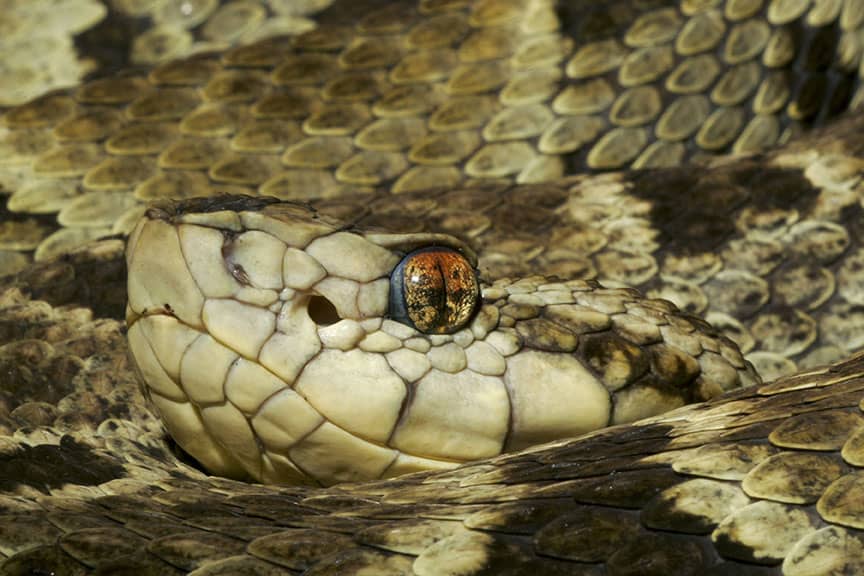The first time I saw a Fer de Lance I had never heard of it nor did I have any idea how dangerous it was. Luckily the friend I was with did! We were going around Costa Rica photographing birds, monkeys and the like and we were in Carara National Park when we saw it.
So the question I have is: Have you ever heard about Costa Rica’s most deadliest snake? In this post, you’ll learn 23 Fer de Lance facts, including diet, size, habitat, unique features and more. Plus photos and a video or two of the world’s most deadliest snake.
Fer De Lance Facts (Bothrops Asper)
- Latin name: Bothrops asper
- Range: Southern Mexico to northern South America
- Population Status: it’s regarded as a “Least Concern” species on the IUCN Red List
- Weight: Up to 13 pounds
- Length: Usually about 5 to 6 ft (150–180 cm) long, the fer-de-lance may reach a maximum length of about 9 ft (3 m)
- Diet: These snakes feed on lizards and arthropods
- Physical features (Or Odd facts): It can be gray, brown, olive, or green depending on what color it needs to be.
1. What is a Fer de Lance?
It is a species of snake in the family vipers. It is found throughout Southern Mexico, Central America and the northwestern coast of South America
2. Where does a Fer de Lance Live in Costa Rica?
Their preferred habitats include all moist environments located at low to middle elevations up to 2,000 ft (600 m) like tropical rainforests.
They can be spotted in Palo Verde National Park, Chirripó National Park, Corcovado National Park, Tortuguero National Park and Carara National Park.
3. What does the Fer de Lance look like?
The large head is V-shaped like a lance and quite distinguishable from the neck. The eyes are rather large and the head is darker in color on top and a light creamish-yellow on the underside.
Their color and pattern varies, but the basic color is normally shades of brown and dark gray.Light colored stripes outline the dark diamond shapes on the upper body and sides.
4. How big is a Fer de Lance?
Adults are typically between 4 and 6 feet in length . Although uncommon, females have been observed at lengths of 8.2 feet.
5. How much does a Fer de Lance weigh?
It can weigh up to 13 pounds.
6. Does a Fer de Lance have Fangs?
Oh boy do they! The fangs release a strong, fast acting hemotoxic venom.
7. What is the Fer de Lances Latin name?
Bothrops asper
8. Are Fer de Lances Nocturnal?
They are mainly nocturnal and hide for the majority of the day
9. Are Fer de Lances Aggressive?
This snake has been known to be very aggressive.
10. Can a Fer de Lance Kill a Human?
Ohhh yeah… in fact it is responsible for 99% of all human venomous bites in the entire Amazon Basin.
11. How Long does a Fer de Lance Live?
In captivity it can live more then 20 years.. In the wild well thats up alot of other factors.
12. What Eats a Fer de Lance?
The fer-de-lance is often preyed upon by other snakes such as the coral snake and blacktail indigo. It is also a favorite of certain birds of prey like falcons and eagles
13. Is the Fer de Lance endangered?
No, It is not uncommon.
14. What Does a Fer de Lance eat?
The adults feed on all kinds of small animals including mammals, amphibians, and reptiles. Younger snakes prefer small lizards and invertebrates.
15. How Does Fer de Lance Hunt?
Fer-de-lance specialize in hunting warm blooded prey such as rodents and birds. Its fangs inject hemotoxic venom into its prey, which quickly coagulates the blood and breaks down capillary walls causing internal bleeding and swelling.
16. How Do Fer De Lance Detect their Prey?
To detect their warm blooded prey, these snakes rely on their pit organ located between the eye and nostril. This organ relays thermal information to the snake about the position of their prey
17. What is the Nickname of the Fer de Lance in Costa Rica?
Its Called the Costa Rican landmine.
18. Does a Fer de Lance Lay Eggs?
Yes – Females gives birth to 60 to 80 live babies after pregnancy of 3 to 4 months.
19. At What Age does Fer de Lance Reproduce?
The Fer de Lance reaches sexual maturity at 3 to 4 feet for females while males average at 3 feet
20. What is the Spanish Name for a Fer de Lance?
The fer-de-lance, known in Spanish as barba amarilla (“yellow chin”)
21. How many eggs does the Fer de Lance lay?
A Fer De Lance can lay up to 80 eggs at one time
22. What is a young Fer de Lance Like?
They are brighter colored than their parents, with either beige or yellow tails. They are semi arboreal and actively climb trees, but tend to lose this habit when they become adults.
23. Does A Fer de Lance live in groups?
No they are solitary snakes and prefer to be on their own.






